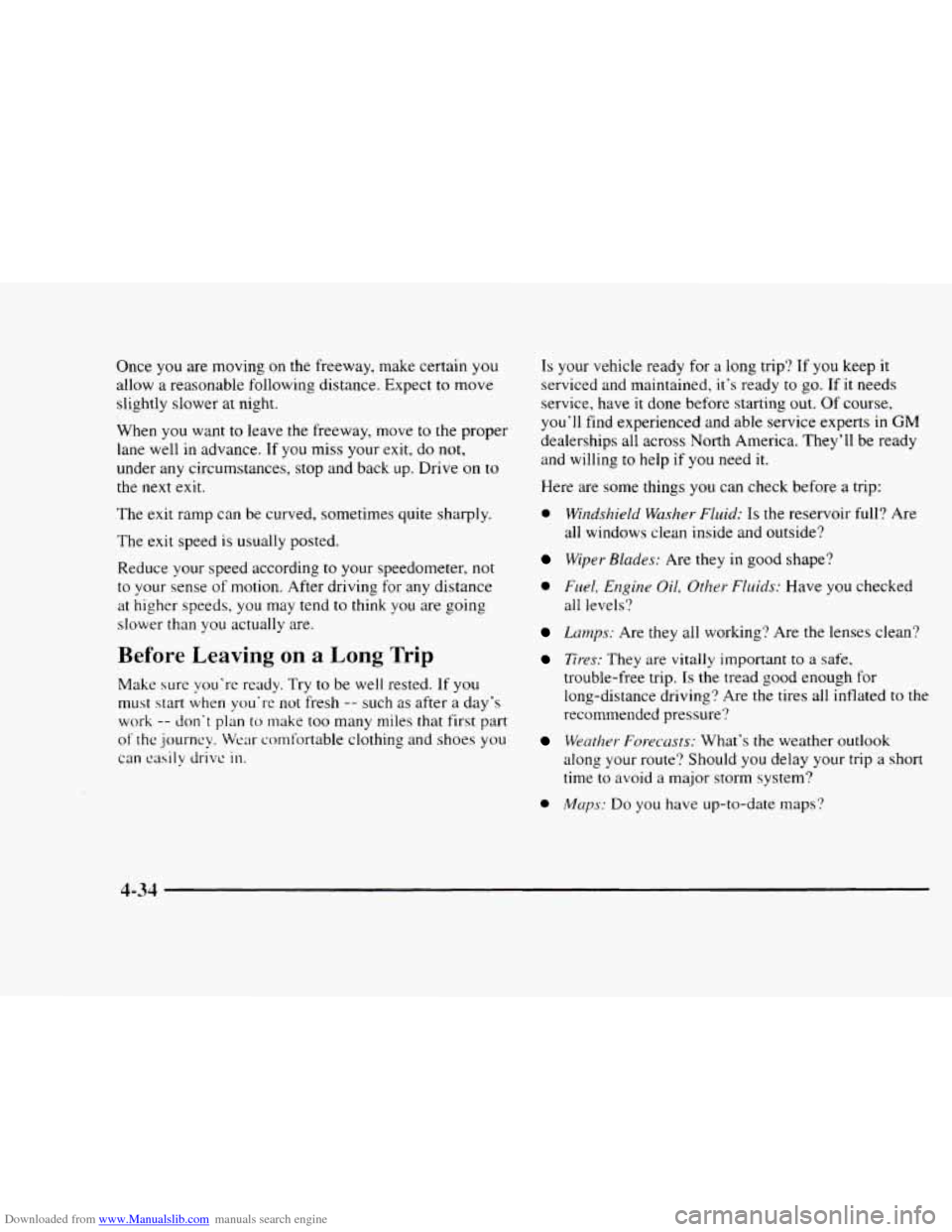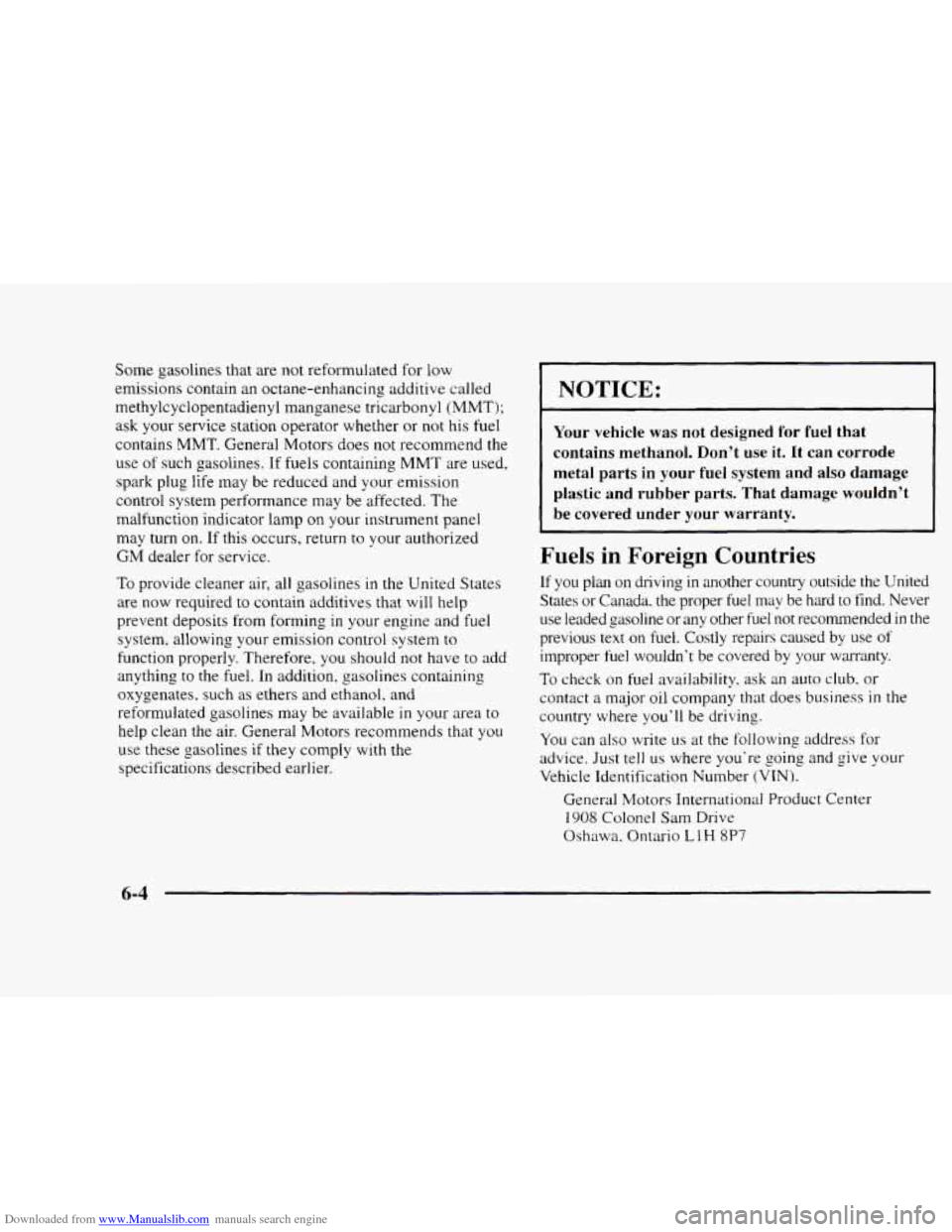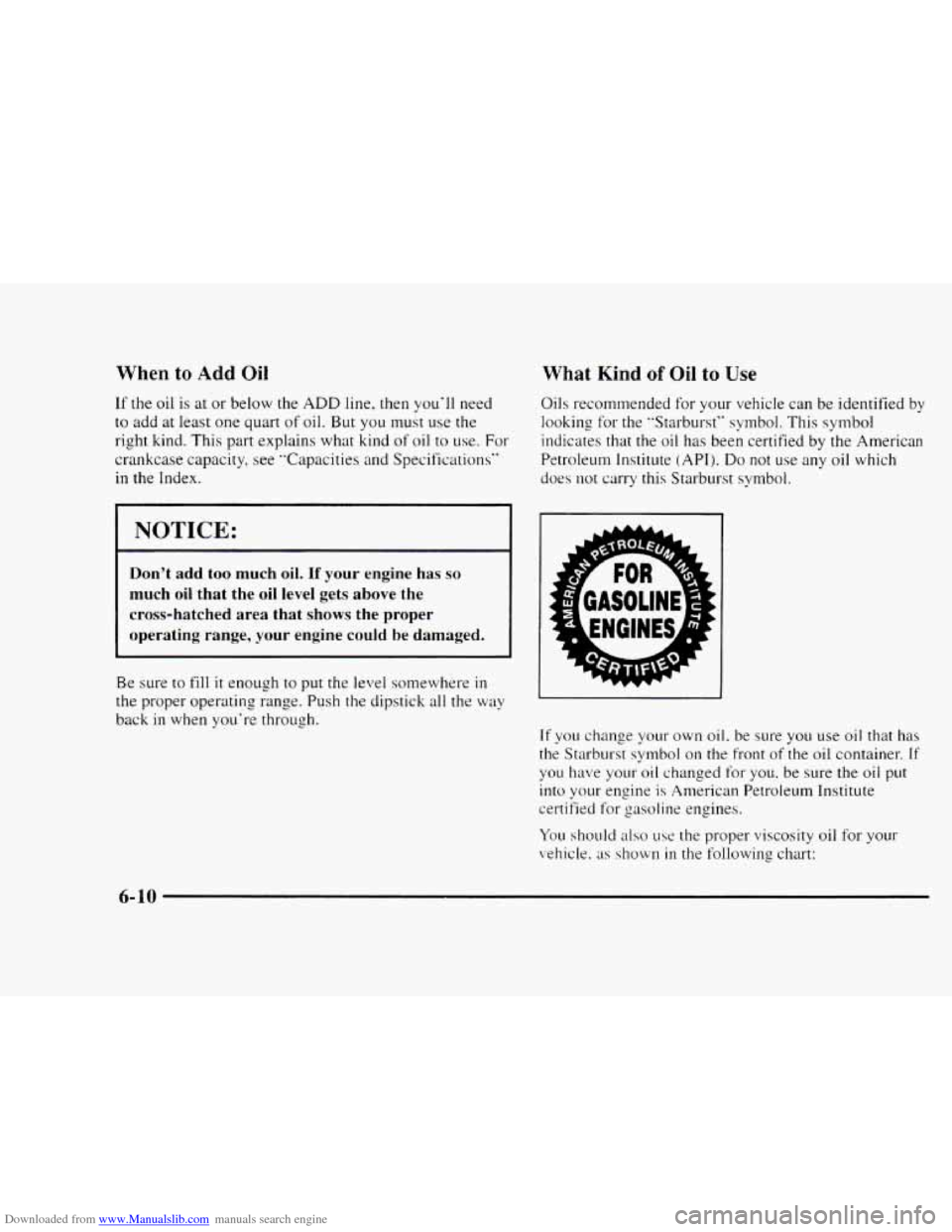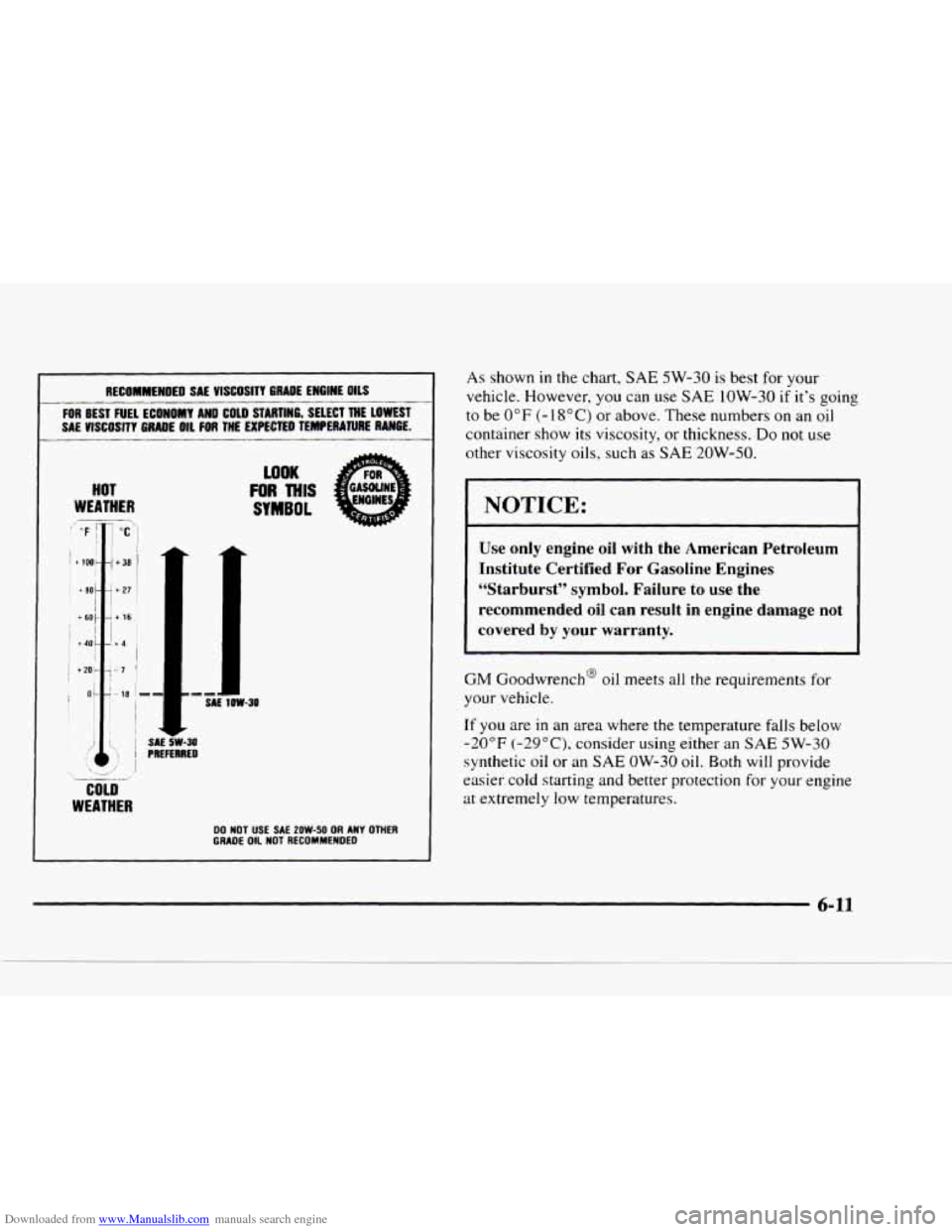1997 CHEVROLET BLAZER recommended oil
[x] Cancel search: recommended oilPage 195 of 402

Downloaded from www.Manualslib.com manuals search engine Once you are moving on the freeway, make certain you
allow a reasonable following distance. Expect to move
slightly slower at night.
When you want
to leave the freeway, move to the proper
lane well
in advance. If you miss your exit, do not,
under any circumstances, stop and back up. Drive on to
the next exit.
The exit ramp can be curved, sometimes quite sharply.
The exit speed is usually posted.
Reduce your speed according to your speedometer,
not
to your sense of motion. After driving for any distance
at higher speeds, you may tend to think you are going
slower than
you actually are.
Before Leaving on a Long Trip
Make sure you're ready. Try to be well rested. If you
must start when you're not fresh -- such as after a day's
work -- don't plan to make too many miles that first part
of the journcv. Wear comfortable clothing and shoes you
can easily drive in.
Is your vehicle ready for a long trip? If you keep it
serviced and maintained,
it's ready to go. If it needs
service, have
it done before starting out. Of course,
you'll find experienced and able service experts
in GM
dealerships all across North America. They'll be ready
and willing to help if
you need it.
Here are some things you can check before a trip:
0 Windshield Washer Fluid: Is the reservoir full? Are
all windows clean inside and outside?
Wiper Blades: Are they in good shape?
0 Fuel, Engine Oil, Other Fluids: Have you checked
all levels?
Lurrzps: Are they all working? Are the lenses clean?
Tires: They are vitally important to a safe,
trouble-free trip.
Is the tread good enough for
long-distance driving? Are
the tires all inflated to the
recommended pressure'?
Weather For-ecvrsts: What's the weather outlook
along your route? Should
you delay your trip a short
time to avoid
a major storm system?
0 Maps: Do you have up-to-date maps'!
4-34
Page 233 of 402

Downloaded from www.Manualslib.com manuals search engine How to Add Coolant to the Coolant
Recovery Tank
If you haven‘t found a problem yet, but the coolant level
isn‘t at the ADD mark, add a SO/SO mixture of clenrz
wter (preferably distilled) and DEX-COOL”
(silicate-free) antifreeze at the coolant recovery tank.
(See ”Engine Coolant”
in the Index for more
information.)
A CAUTION:
Adding only plain water to your cooling system
can be dangerous. Plain water, or some other
liquid like alcohol, can boil before the proper
coolant mix
will. Your vehicle’s coolant warning
system
is set for the proper coolant mix. With
plain water
or the wrong mix, your engine could
get too hot but >‘ou wouldn’t get the overheat
warning. k‘our
engine could catch fire and you or
others
could he hurned. Use a 50/50 mix of clean
water and DKX-CWOL” coolant.
NOTICE:
In cold weather, water can freeze and crack the
engine, radiator, heater core and other parts.
Use the recommended coolant and the proper
coolant
mix.
5-16
Page 259 of 402

Downloaded from www.Manualslib.com manuals search engine Some gasolines that are not reformulated for low
emissions contain an octane-enhancing additive called
methylcyclopentadienyl manganese tricarbonyl
(MMT);
ask your service station operator whether or not his fuel
contains MMT. General Motors does not recommend the
use of such gasolines.
If fuels containing MMT are used,
spark plug life may be reduced and your emission
control system performance may be affected. The
malfunction indicator lamp
on your instrument panel
may turn on.
If this occurs, return to your authorized
GM dealer for service.
To provide cleaner air, all gasolines in the United States
are now required to contain additives that will help
prevent deposits from forming in your engine and fuel
system, allowing your emission control system to
function properly. Therefore, you should not have to add
anything to
the fuel. In addition, gasolines containing
oxygenates, such as ethers and ethanol. and
reformulated gasolines may be available
in your area to
help clean the air. General Motors recommends that you
use these gasolines if they comply with the
specifications described earlier.
I NOTICE:
Your vehicle was not designed for fuel that
contains methanol. Don’t
use it. It can corrode
metal parts
in your fuel system and also damage
plastic and rubber parts. That damage wouldn’t
be covered under your warranty.
Fuels in Foreign Countries
If you plan on driving in another country outside the United
States or Canada. the proper fuel may be hard
to find. Never
use leaded gasoline or any other fuei
not recommended in the
previous text on fuel. Costly repairs caused
by use of
improper fuel wouldn’t be covered by your warranty.
To check
on fuel availability, ask an auto club. or
contact a major oil company that does business
in the
country where
you’ll be driving.
You can also write us at the following address for
advice. Just tell us where you’re going and give your
Vehicle Identification
Number (VTN).
General Motors International Product Center
1908 Colonel Sam Drive
Oshawa. Ontario
L 1 H 8P7
6-4
Page 265 of 402

Downloaded from www.Manualslib.com manuals search engine When to Add Oil
If the oil is at or below the ADD line. then you'll need
to add at least one quart of oil. But you must use the
right kind. This part explains what kind
of oil to use. For
crankcase capacity, see "Capacities and Specifications"
in the Index.
NOTICE:
Don't add too much oil. If your engine has so
much oil that the oil level gets above the
cross-hatched area that shows the proper
operating range, your engine could be damaged.
Be sure to fill it enough to put the level somewhere in
the proper operating range. Push the dipstick all the way
back
in when you're through.
What Kind of Oil to Use
Oils recommended for your vehicle can be identified by
looking for the "Starburst" symbol. This symbol
indicates that
the oil has been certified by the American
Petroleunl Institute
(API). Do not use any oil which
does not carry
this Starburst symbol.
If you change your own oil. be sure you use oil that has
the Starburst symbol
on the front of the oil container. If
you have your oil changed for you, be sure the oil put
into your engine is American Petroleum Institute
certified for gasoline engines.
You should
also use the proper viscosity oil for your
vehicle. as
shown in the following chart:
6- 10
Page 266 of 402

Downloaded from www.Manualslib.com manuals search engine SAL VISCOSITY GRADE ENGINE OILS
FOR BEST FUEL ECONOMY AN0 COLD STARTING, SELECT THE LOWEST
SAE
VISCOSITY GRADE OIL FOR THL'EXPECTED TEMPERATURE RANGE.
HOT
WEATHER
'---.l
COLD
WEATHER
LOOK
FOR THIS
SYMBOL
DO NOT USE SAE 2OW-50 OR ANY OTHER GRADE OIL NOT RECOMMENDED
As shown in the chart, SAE 5W-30 is best for your
vehicle. However, you can use
SAE 1OW-30 if it's going
to be 0" F (- 1 8 "C) or above. These numbers on an oil
container show its viscosity, or thickness. Do not use
other viscosity oils, such as SAE 20W-50.
I NOTICE:
Use only engine oil with the American Petroleum
Institute Certified For Gasoline Engines
"Starburst" symbol. Failure to use the
recommended
oil can result in engine damage not
covered by your warranty.
GM Goodwrench@ oil meets all the requirements for
your vehicle.
If you are in an area where the temperature falls below
-20°F (-29OC), consider using either an SAE 5W-30
synthetic oil or an SAE OW-30 oil. Both will provide
easier cold starting and better protection for your engine
at extremely low temperatures.
6-11
Page 321 of 402

Downloaded from www.Manualslib.com manuals search engine Introduction
IMPORTANT:
KEEP ENGINE OIL
AT THE PROPER
.VEL AND CHANGE
RECOMMENDED
protection I
Your Vehicle and the Environment
Proper vehicle maintenance not only helps to keep your
vehicle in
good working condition, but also helps the
environment. All recommended maintenance procedures
are important. Improper vehicle maintenance can even
affect the quality
of the air we breathe. Improper fluid
levels or the wrong tire inflation can increase the level
of emissions from your vehicle. To help protect our
environment, and
to keep your vehicle in good
condition. please maintain your vehicle properly.
7-2
Page 326 of 402

Downloaded from www.Manualslib.com manuals search engine Short TripKity Maintenance Schedule
The services shown in this schedule up to 100,000 miles
( 166 000 km) should be performed after 100,000 miles
(166 000 km) at the same intervals. The services shown
at
150,000 miles (240 000 km) should be performed at
the same interval after 150,000 miles
(240 000 km).
See “Owner Checks and Services” and “Periodic
Maintenance inspections” following.
Footnotes
? The U.S. Environmental Protection Agency or the
California Air Resources Board has determined that
the
failure to perform this maintenance item will not nullify
the emission warranty or limit recall liability prior
to the
completion of the vehicle’s
useful life. We, however,
urge that all recommended maintenance services
be
performed at the indicated intervals and the maintenance
be recorded.
# Lubricate the front suspension, ball joints, steering
linkage and transfer case shift linkage, parking brake
cable guides, propshaft splines, universal joints and
brake pedal springs.
+ A good time to check your brakes is during tire
rotation. See “Brake System Inspection” under “Periodic Maintenance Inspection” in Part
C of this schedule.
** Drive axle service (see “Recommended Fluids and
Lubricants’’ in
the Index for proper lubricant to use):
0
a
0
Locking Differential -- Drain fluid and refill at first
engine oil change. At subsequent oil changes, check
fluid level and add fluid as needed. If driving in
dusty areas or towing a trailer, drain fluid and refill
every
15,000 miles (25 000 km).
Standard Differential -- Check fluid level and add
fluid
as needed at every oil change. If driving in
dusty areas
or towing a trailer, drain fluid and refill
every
15,000 miles (25 000 km).
More frequent lubrication may be required for
heavy-duty
or off-road use.
Page 349 of 402

Downloaded from www.Manualslib.com manuals search engine The services shown in this schedule up to 100.000 miles
( 166 000 km) should be performed after 100,000 miles
( 166 000 km) at the same intervals. The services shown
at
150.OOO miles (240 000 km) should be performed at
the same interval after 150.0OO miles
(240 000 km ).
See "Owner Checks and Services" and "Periodic
Maintenance Inspections" following.
Footnotes
-f- The U.S. Environmental Protection Agency or the
California Air Resources Board has determined that the
failure to perform this maintenance item.
will not nullify
the emission warranty or limit recall liability prior to the
completion of the vehicle's useful life. We. however.
urge that all recommended maintenance services be
performed at the indicated intervals and the maintenance
be recorded.
# Lubricate the front suspension, ball joints, steering
linkage and transfer case shift linkage. parking brake
cable guides. propshaft splines. universal joints and
brake pedal springs.
+ A good time to check your brakes is during tire
rotation. See "Brake System Inspection" under "Periodic
Maintenance Inspections" in
Part C of this schedule.
** Drive axle service (see "Recommended Fluids and
Lubricants"
in the Index for proper lubricant to use):
Locking Differential -- Drain fluid and refill at first
engine oil change. At subsequent oil changes, check
fluid level and add fluid as needed.
Standard Differential -- Check fluid level and add
fluid as needed
at every engine oil change.
More frequent lubrication may be required for
heavy-duty or off-road use.
7-30